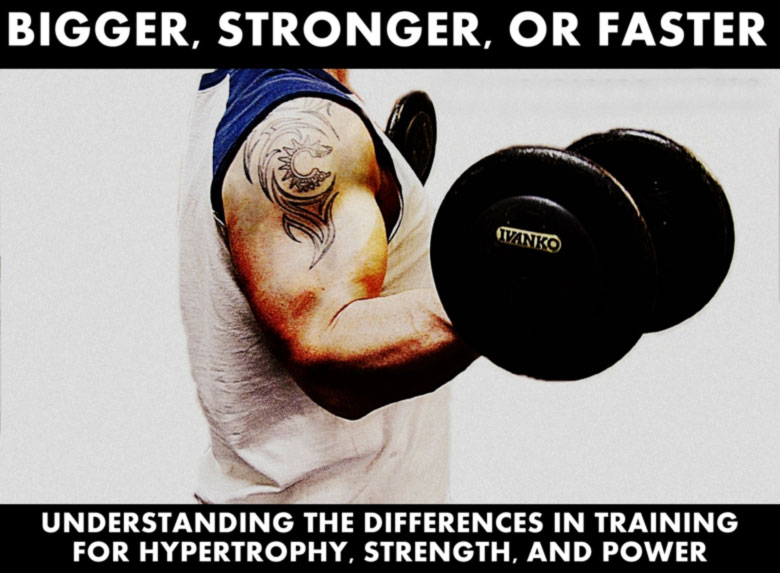Bigger, Stronger, or Faster
There are very few absolutes in the world of strength and conditioning. There are a million ways to get big and a million ways to get strong; anybody who claims to have the single best method for developing either is full of shit. Just about the only thing you can count on is that the development of strength, power, or size requires progressive overload, and unless you’re a novice, the significant development of any of them will not be achieved through the same means.
Lifting makes muscles grow. That’s about the extent to which most people understand weight training, but there’s clearly much more to it than that. The body has specific adaptations to specific different training demands. In order to be bigger, stronger, faster, or some combination of the three there needs to be an understanding that they aren’t achieved through the same means.
Generating Hypertrophy
In a nutshell, hypertrophy occurs when skeletal muscle fibers repair from the damage created by training. These fibers are generally lumped into 3 categories (in reality there’s at least 7): slow twitch (type I), fast twitch (type IIX), and intermediate (type IIA), which are innervated under different loads and circumstances. Generating hypertrophy requires using different stimuli to recruit, damage, and develop the full spectrum of muscle fibers.
Aside from the moderate amount of necessary strength work (more on this in a bit), hypertrophy can be seen as an endurance endeavor. Due to the nature of type I fibers, they require significantly more volume for development. Training with a longer time under tension through a slower tempo or higher reps, and the implementation of strategies designed to create as much muscle trauma as possible is necessary to get a muscle to grow. The point of emphasis lies more in driving tension into a muscle and feeling it contract with every rep than piling on weight on a barbell and moving it from point A to point B.
That isn’t to say there isn’t a fair amount of size to be had when lifting with heavier loads. A focus on strength will recruit the easier to grow fast twitch fibers and eventually allow heavier loads to be used with higher volumes, creating more damage. However, by continually focusing on absolute strength and power production neglects sufficient damage to roughly half of the muscle fiber, leaving a lot of size on the table. Thorough development of the less powerful and fatigue resistant type I fibers means using lower intensities and greater volumes than those used in most strength specific work.
The cyclical breakdown and recovery of a muscle will result in several physiological changes. As a muscle adapts to a continually higher volume of work it will most likely experience greater blood flow, increased stores of muscle glycogen, and of course greater muscle size across all fiber types, but little has been done to create the neurological adaptations necessary to move heavy loads or produce more power.
Developing Strength and Power
Contrary to what many people believe, strength and power are not one in the same. Strength is the simply ability to move a load whereas power is the expression of the time it takes to move a load. Regardless of their differences, it takes more than the adaptations from muscle trauma to create either. Their development is more about adaptations to the nervous system and less about breaking down muscle tissue, making them more similar to a skill. Like any skill, efficient neurological pathways need to be created. This happens by focusing on moving weight with a specific technique and/or speed, and less about consciously flexing a specific muscle. The concern lies in properly training a movement pattern, not which muscle is being isolated. It’s these neurological adaptations, much more than increased muscle hypertrophy, that lead to gains in strength and power.
Yes, you will generate hypertrophy while training to develop power or strength, but nowhere near the extent of a bodybuilder. Velocity generated hypertrophy is a result of the growth experienced by the type IIX and even IIA fibers. Type IIX fibers are capable of producing force at a high velocity and are the most susceptible to growth, whereas type IIA fibers can be trained to take on type IIX characteristics and experience similar changes. Consider sprinting, arguably the greatest expression of power. It will develop significant growth in fast twitch fibers, but leave the slow twitch fibers fairly underdeveloped. In fact, if it’s your goal to move your body as fast as possible excessive hypertrophy is nothing more than unnecessary weight that will slow you down.
The way in which hypertrophy is generated through maximal, or near maximal loads is basically the same as when training with the submaximal loads used in bodybuilding. A max effort attempt will recruit all fiber types and there will be damage (and growth) across all muscle fibers. The difference lies in the amount of trauma placed upon them. With respect to proper loading parameters, trauma to a muscle is largely a product of training volume. Attempting to maintain a high training volume at maximal or near maximal loads is not sustainable, making increases in size as significant as a bodybuilder unlikely.
The neurological demand of strength and power production will limit how much work you can accomplish in a given training session. To paraphrase Charlie Francis, “In the real world, where you don’t have the capacity to do everything, you must choose to do what will benefit you the most.” If you expect to develop a significant amount of strength you need to do a significant amount of strength work. A fair amount of time is spent moving loads that are greater than 80% of your 1RM and lower intensities are trained in a manner meant to improve power, both are neurologically demanding. Once you factor in overtraining, CNS demand, and other training limitations such as a drop in hormone production over time you have little time and ability left to spend on volume and time under tension.
Are There Two Types of Muscle Hypertrophy?
Most people associate hypertrophy with increases in the actual size of the muscle and its contractile components. When a muscle becomes damaged it will respond by furthering its ability to handle more stress (i.e. load and repetitive action) with an increased in the size and possibly number of muscle fibers contained within a muscle belly, also known as hyperplasia. This increase in contractile components is referred to as myofibril hypertrophy.
The other often referenced cause of muscle growth is sarcoplasmic hypertrophy. It’s simply a reference to the increase of non-contractile components in the muscle, basically an increase the intracellular fluid within a muscle. Sarcoplasmic hypertrophy is commonly referred as nonfunctional hypertrophy because it does nothing to improve the contractile properties of the muscle, leading only to increases in its size.
The existence of sarcoplasmic hypertrophy is still up for debate. Prominent names in the strength and conditioning field such as Vladimir Zatsiorsky, Mel Siff, and Charles Poliquin go into greater depth differentiating it between myofibril hypertrophy, but evidence supporting it is scant. Most is sited from obscure Cold War era research that never made it across the iron curtain and is largely anecdotal in Western training philosophies. Though it’s easily dismissed as broscience the increased density of mitochondria and capillaries within muscle tissue does lend some support to the idea of sarcoplasmic hypertrophy.
Final Thoughts
Whether or not there are two different types of hypertrophy remains to be seen, but for the sake of the general population it’s largely irrelevant. Training methods to generate sarcoplasmic hypertrophy are basically high volume/high trauma sets, and necessary regardless of what you call the outcome. What is clear is that not all muscle growth is the same and different training programs yield different results. You’re not going to get freakishly huge training only for strength and you’re not going to get freakishly strong training only for size.
Strength, power, and size development are not quite as intertwined as most people believe, but they’re not mutually exclusive either. Increases in muscle size while training for strength and power are merely a side-effect of training, not the intent. Athletes are judged on performance, not appearance. When focusing on hypertrophy, size is the intent, and therefore maximized. Nobody cares how much a bodybuilder can squat or how high he can jump. All that matters is how he looks on stage.
Size, power, and strength can be a synergist to one another and in many cases a necessary one. Though it is prudent to direct a training program toward the desired goal, a properly designed program will get you strength, size, and just about any other desired adaptation. That however, is a topic about program design which merits its own conversation at a later time.


 Tweet
Tweet




